National History Textbooks in East Asia
This page compares textbooks of modern history in Japan, South Korea, China and Taiwan. Each country has own principle to edit its textbook. While Japan, South Korea and Taiwan support the value of liberal democracy, the purpose of history education in China is to sustain the dictatorship of Communist Party. While South Korea and China are very anti-Japan, Taiwan is relatively pro-Japan. Such differences result in different description of the same historical event. In the case of war, of course each country justifies itself and blame the enemy.
English translations are only summaries and the quality is not guaranteed. This is why the original texts are shown. Texts from Chinese and Taiwanese textbooks are pseud Chinese written in Japanese Kanji. In a quotation, for example, "J:xx" refers to the page xx in Japanese textbook. The meaning of capitals J, K, C and T will be very evident.
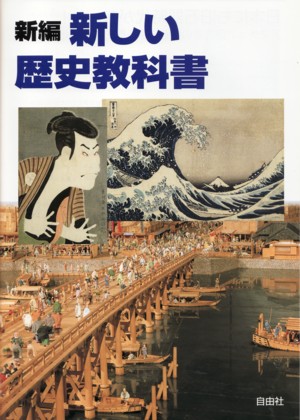 J:wVÒ@Vµ¢ðj³Èx©RÐ, 2009.
J:wVÒ@Vµ¢ðj³Èx©RÐ, 2009.
In Japan, school textbooks are investigated and permitted by the government. There were seven textbooks of Japanese history for junior high school students in the academic year 2010. This textbook published by Jiyusha was permitted in 2009, descending the Fusosha version permitted in 2000. This Jiyusha version and old Fusosha version were written by right wing revisionists and are supposed to be one of the most nationalistic textbooks. China and South Korea have shown strong hostility against these nationalistic textbooks. Left wing activists that are sympathetic to China and Korea have been making severe protests against municipalities that decided to use these textbooks. As the result, this Jiyusha edition was used only in 1% of junior high schools in 2010.
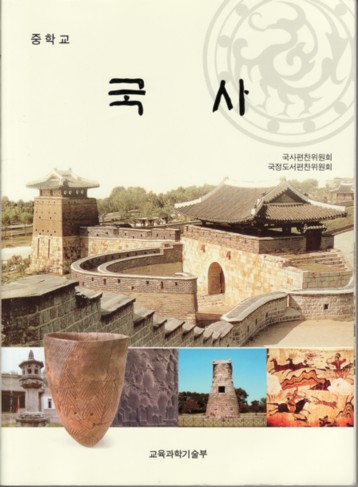 K: 국사편찬위원회, 국정도서편찬위원회, 교육과학기술부, "중학교 국사," 2009년 3월 1일 8쇠 발행.
K: 국사편찬위원회, 국정도서편찬위원회, 교육과학기술부, "중학교 국사," 2009년 3월 1일 8쇠 발행.
In South Korea, only the government could edit and publish a textbook of Korean history in the primary education. The history education has been the focus of ideological battle between the left and right. As the result, the curriculum in the secondary education is rapidly changing and a governmental textbook is not used anymore in high schools. I don't know what change is going on in the primary level. At least in the academic year of 2009, this governmental edition was the only textbook in junior high school.
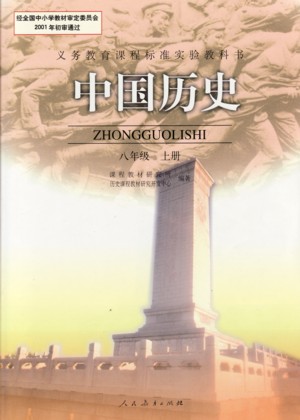 C1: Ûö³Þ¤EðjÛö³Þ¤JSÒwðj ªNãûxl¯³çoÅÐ, 2009N6æ10óü.
C1: Ûö³Þ¤EðjÛö³Þ¤JSÒwðj ªNãûxl¯³çoÅÐ, 2009N6æ10óü.
C2: Ûö³Þ¤EðjÛö³Þ¤JSÒwðj ªNºûxl¯³çoÅÐ, 2010N11æ9óü.
Also in China, only the government can edit history textbooks. These textbooks were used for the 8th grade students in 2011. While the volume 1 (C1) contains modern Chinese history from the First Opium War in 1840 to the end of the World War II , the volume 2 (C2) describes from the establishment of People's Republic of China to the present.
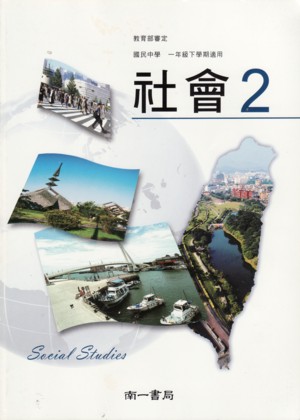 T: ³çRèC ¯{êNº{úKpwÐðQxìêÇ, 2008.
T: ³çRèC ¯{êNº{úKpwÐðQxìêÇ, 2008.
Taiwan has the permission system as in Japan and most developed countries for national history textbooks. This textbook is for the latter half of the 7th grade students and was published by Nanyi Books Company in Tainan City. This is a textbook of society, including geography, history and other social sciences. The history part describes from the annexation to Japan in 1905 to the present.
Western Impact
In East Asia, Taiwan was the earliest to experience the Western Impact. The Dutch East India Company occupied the Southern part of Taiwan in 1624 and ruled for 38 years. At that time, there was no government in Taiwan where only aborigines and pirates inhabited. In 1661, Konxinga was defeated by the Qing dynasty and moved into Taiwan to push out the Dutch. The Qing dynasty invaded Taiwan in 1683 and ruined the government of Zheng clan. This marks the annexation of Taiwan to China.
In the 19th century, the British military power was strong enough to threat the Qing dynasty. Qing was defeated in the First Opium War and was forced to sign the Treaty of Nanking in 1842. The Chinese textbook asserts that China lost because the Daoguang Emperor was coward and incompetent. Such factors as Sinocentrism or ignorance of Western power are not mentioned in this textbook.
ßC´RÝÈkh±óCpRUè´]èCCp±kãC¼NVÃB¹õé\ª惊°Ch¼è®ÂûgP^pRk»C@«Ñ¥PE¸ÙB(C1:4)
At that time, the Qing dynasty did not have defense forces in the north from Fujian. When the British occupied Tianjin, the Daoguang Emperor was frightened and sent Qishan to make peace and fired Lin Zexu.
|
According to the Japanese textbook, Japan was shocked by the Opium War even more than China itself. The textbook proudly describes the ability of Japan to collect information on foreign affairs.
±ÌîñÍú{Éà½ç³êCå«ÈÕð^¦½[1]B
[1] AwíÌîñÍuI_àvðʵÄú{É`¦çêC¯OÉàLÜÁ½B(J:135)
Details of the Opium War were informed to Japan by the Dutch and even ordinary people knew them.
|
When the U.S. commodore M.C. Perry came to Japan to open the country, the Tokugawa shogunate knew that Japan cannot resist for a long time. Thus, Japan concluded the Convention of Kanagawa in 1854. Anti-bakufu hans such as Satsuma and Choshu devoted themselves to the gSonno Joih movement expelling foreigners. But they quickly learned the necessity to accept Western institute and technologies through battles with Western nations.
ú{Í]ËãðʶÄCÆÐïÆ¢¤Êª èCñÌRIºÐÉq´É½µ½BÆÉFÆ·BÌñÂÌLÍÈ˪ɢÄÆíðµ½ÊC¢ÄÆú{ÌÍÌ·ðÉØÉF¯µC¼m¶¾ðÏÉIÉwÔûüÉôð]·µ½B(J:148)
Japan was a military country in the Tokugawa period and was sensitive to the Western threat. Major hans such as Satsuma and Choshu realized the difference in military power after they fought against Western countries and decided to learn the Western civilization.
|
Even after China and Japan opened to the West, Korea stayed as the ghermit nation.h Although France and the U.S. attacked Korea in 1866 and 1871, respectively, these expeditions were unsuccessful. The Korean textbook evaluates such exclusionism rather positively.
서양과 일본에 대한 조선의 통상 수교 거부 정책은 우리 나라가 서양의 새로운 문물을 받아들이는 시기를 늦어지게 한 문제점도 있으나, 외세의 침략을 막으려 한 자주적 성격을 지니고 있었다.
(K:194)
While the foreign expelling policy delayed the acceptance of the Western civilization, it was expression of autonomy to stop the foreign invasion.
|
Japan-Qing War
In 1894, the Yi dynasty of Korea asked of the Qing dynasty to send the army to repress the Tonghak riot. Japan also sent its army and the Japan-Qing War (First Sino-Japanese War) broke out. The Japanese textbook describes as follows;
í¸©ÈºÍµ©à½È¢©N¤©ÍC´ÉÁ³Ì½ßÌoºðß½ªCú{à´ÆÌ\µ í¹ðûÀÉRàðhµCú´¼RªÕ˵Äú´íªÍ¶ÜÁ½B(J:164)
Korean dynasty had little military force and had to ask Qing to send the army for repression. Japan also sent its army based on the promise with Qing and the Japan-Qing War started.
|
The Korean textbook writes that Japan sent the army even though Korea did not ask, and that the war broke out by Japan's provocation.
전주 화약을 맺은 후 농민군이 해산하자, 정부는 일본군의 철수를 요구하였다. 그러나 일본은 이를 거부하고 오히려 궁궐을 침범하였으며, 청-일전쟁을 일으켰다.(K:209)
After the peace was made with the rebel, the government asked Japan to withdraw. However, Japan denied and invaded the palace, outbreaking the Qing-Japan War.
|
According to the Chinese textbook, Japan already had intention to invade China at that time.
1894NCú{×À»ª©NCNªCÌe¢EI²zCoºèÌ©Ns¿éCÚ
C®NªíBêN¥ïbßNCöCí©ôgbßúíhB(C1:16)
In 1894, Japan occupied the Korean capital to dominate Korean peninsula, to invade China and to show its supremacy for the world. Then, they started an invasion war. Because this year was Yang Wood Horse in sexagenary cycle, this war is called "Yang Wood Horse China-Japan War".
|
The Japanese textbook has only a brief description on the process of war.
íêÍ©NÌÙ©CBikjìÈÇÉLªèCú{ͤíÅàCíÅà´ð³|µCµ½B(J:164)
The battle field expanded from Korea to Southern Manchuria. Japan overwhelmed Qing both on the land and the water.
|
On the other hand, the Chinese textbook has very detailed descriptions on the Battle on the Yellow Sea (Battle of the Yalu River) and the Port Arthur Massacre. After the Battle on the Yellow Sea, the Beiyang fleet of China could not operate again and Japan took the command of the sea. However, the Chinese textbook asserts that the Beiyang fleet won.
oßܽíCú{ÍàñæÞoíêBkmÍà¸ìÇCãÔqB(C1:17)
After the fierce fight for five hours, the Japanese fleet first withdrew from the battle field. The Beiyang fleet attempted to chase it, and then returned to the port.
|
The Chinese textbook eagerly praises a Chinese admiral Deng Shichang, mobilizing a sad story about his dog.
¼º½J«nÍC©úͳBúÍQZç]ðC¯úà{C¾vÍBû¹¢¹^ñS]¼ímsó]µB(C1:17)
He ordered to make his cruiser Chih Yuen to rush at a Japanese ship. The Japanese were frightened and shot cannons to sink Chih Yuen. Deng Shichang and his 200 men died heroically.
¼I¤¢ò¬àCXZ¼IßCg¼Ù@º¾Bû¹¢¹{pÍzc¤¢û°CAXZsúBû¹¢¹àÁ¹àÁSCp諤¢Âü
BsêïC¼ìAêN¾üÉgcc(C1:16)
His dog swiftly swam to him, bit his close and tried to save him. Deng Shichang attempted to push out the dog, but the dog never accepted to leave the master alone. Finally, Deng gave up saving his dog and went under the water togethercc
|
The Japanese textbook proudly asserts the reason of victory as follows;
ú{ÌöƵÄÍCVºíÌõÉÁ¦CRàÌPûEK¥ÉܳÁÄ¢½±Æª °çêéªC»ÌwiÉÍCú{lSÌÌÓ¯ªC¯ÆµÄêÂÉÜÆÜÁÄ¢½±Æª éB(J:164-165)
The reasons of victory include equipment of new weapons, better trained and disciplined military forces, and more than anything, the solidity of the Japanese people.
|
There is no analysis on the causes of defeat in the Chinese textbook. Instead, it attempts to raise the anger of readers both through texts and graphics.
ú{RèÌ·ãCá¶jEn¯CïÒß¼lB(C1:17)
After the Japanese occupied the Port Arthur, they committed a terrible massacre. The number of victims was almost twenty thousands.
|
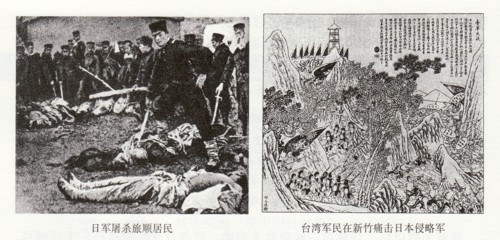
The Treaty of Shimonoseki in 1895 demanded Qing to hand over Taiwan to Japan. The Chinese textbook asserts that the Taiwanese people extremely hated to be annexated to Japan and desparately resisted.
äpl¯ÂètësCWï¦ÐC¾gÃllí§¸äCrsÃiè§÷äBh(C1:17)
The Taiwanese people came out on strike and demonstration march, shouting gwe will never give up Taiwan, rather will die.h
svCäpSérBA¥Cäpe°l¯½Rú{B¯¡CæñAcIlêçvLâ~ßB(C1:18)
Before long, Japan occupied the whole island. However, the Taiwanese people never stopped resisting against the Japanese rule until they returned to China. |
The intention of Chinese editors seems to make students believe that the Taiwanese enthusiastically support gOne Chinah policy and always want to come back to China. However, the Taiwanese textbook does not support such a myth.
ma×ÛCc¿úRüéBúl符Ýäik§snTâXBVãCúRããìºCå«Ýªn½]¯OïRCAIgÁçäiìI«i£äiCú{T§SäiCWJ·BÜ\NIB¯¡B(T:69)
The leaders of Taipei asked of the Japanese army to enter the city to sustain security. The Japanese quickly occupied Taipei and had a ceremony of launching their regime. After that, the Japanese army started proceeding to the South. Although there were some resistances, General Liu Yongfu gave up Tainan city and escaped to the mainland. Japan occupied the whole island and governed for fifty years.
|
Triple Intervention
The Shimonoseki Treaty decided to cede not only Taiwan but also the Liaodong Peninsula to Japan. However, Russia also desired to possess the peninsula and persuaded France and Germany to force Japan to give it up. Japan reluctantly agreed to return the Liaodong Peninsula in exchange for 30 million tales. According to the Chinese textbook, it was still shameful to pay money for it.
âF×Cú{èÌɼCjV©Èükg£Nª¨ÍB°¥C@úº¼oʱÂCgú{cɼAÒBA¥C´{K{ú{3000¼âCì×gwÉïhB(C1:17)
Russia recognized that Japanfs possession of the Liaodong Peninsula would be obstacle to realize its own ambition. Thus, Russia intervened together with France and Germany to force Japan to return the peninsula to China. However, the Qing government had to pay 30 million tales to gpurchase backh it.
|
The Japanese textbook evaluates that the Triple Intervention drove the abhorrence against Russia and determination for the war.
ú{ÍCÌÌÉ éuçd¦_vð¾tÉC¯¯°ÄVAÉÎR·é½ßÌÍÌ[ÀÉwßéæ¤ÉÈÁ½B(J:165)
Under the slogan of "Perseverance and Determination,h the whole Japanese people decided to foster the nationfs power to challenge Russia.
|
The Korean Court was deeply impressed by the Russian power. According to the Korean textbook, the Triple Intervention led the Korean government to invite Russian influence to Korea to preclude Japanfs ambition.
삼국 간섭으로 러시아 세력의 우위가 드러나자, 일본에 대해 불만을 품고 있던 고종과 명성 황후는 러시아 세력을 이용하려는 정책을 추진하였다.(K:221)
When the Russiafs superiority was proved in the Triple Intervention, King Kojong and Queen Min introduced the policy to make use of Russian power to exclude Japanfs influence.
|
The scenario that Russia governs Korea was nightmare for Japan.
©N¼ªCûÉÌyðgåµÂ éVAÌxzºÉüêÎCú{ðU·éiDÌînÆÈèCÌú{ÍC©Ìhqª¢ïÉÈéÆl¦çê½B(J:163)
It was thought that if Russia takes Korea, the peninsula would be the base to invade Japan. Then, the security of Japan would be seriously threatened.
|
To avoid this, a group of the Japanese assassinated Queen Min, who led the pro-Russia policy. This incident is not mentioned in the Japanese textbook.
그리하여 일본 공사는 일본군과 일본인 불량배들을 동원하여 궁궐에 침입하고 명성황후를 시해하는 만행을 저질렀다.
(K:222)
The minister of Japan mobilized the Japanese rascals to assassinate Queen Min. They invaded the palace and slaughtered her.
|
Japan-Russia War
After Japan was forced to return Liaodong, Russia took it. Russian influence in Korea also kept growing. When diplomatic negotiations between Japan and Russia to determine each control sphere failed, Japan decided to fight. On 8 February 1904, Japan attacked the Russian fleet at Port Arthur and the Japan-Russia War (Russo-Japanese War) broke out. In 1905, Japan occupied Port Arthur, pushed out the Russian army from Mukden, and defeated the Baltic Fleet on the Sea of Japan. The Japanese textbook has a long column on the battle with the Baltic Fleet, which is as detailed as the description of the Battle on the Yellow Sea in Chinese textbook.
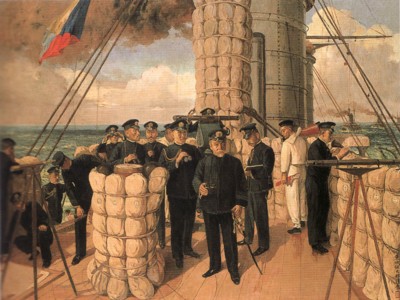 Í40ªÅÜÁ½BøÍXtͽ̽eðó¯CåÎÐ𨱵½Bcc±ÌCíðú{Ìɱ¢½ÌÍCC̽¦Ìæ³ÆCZt̺£ëòª¾µ½«\ÎòÉ éÆ¢íêéBcc¢EÌCíjãC±êÙÇ®SÈðûß½áÍÈ©Á½B(J:171)
Í40ªÅÜÁ½BøÍXtͽ̽eðó¯CåÎÐ𨱵½Bcc±ÌCíðú{Ìɱ¢½ÌÍCC̽¦Ìæ³ÆCZt̺£ëòª¾µ½«\ÎòÉ éÆ¢íêéBcc¢EÌCíjãC±êÙÇ®SÈðûß½áÍÈ©Á½B(J:171)
The battle lasted only for 40 minutes. The flagship Knyaz Suvorov was hit by many shells and burn... Japan won because of the high rate of hit and the quality of gun powder invented by Shimose Masachika... This was the most overwhelming victory in the history of naval battles.
Picture: Commander Togo Heihachiro on the battle ship Mikasa.
Under the mediation by the American President Theodore Roosevelt, Japan and Russia signed the Treaty of Portsmouth which assured Japanfs superiority in Korea. The Japanese textbook asserts that Japan's victory encouraged colonial people under the imperial rule.
ßãÆƵĶÜêÄÜàÈ¢LFlíÌú{ªCC¢EÅå̤Rå¾Á½léVAÉÁ½±ÆÍCA¯nɳêÄ¢½¯°ÉCƧÖÌó]𠽦½B(J:170)
The fact that a country of colored race has beaten the white imperial power with the strongest army showed the possibility of independence for colonial people.
|
Not only people in imperial colonies but also Finn, Polish and Turkish people under the Russian pressure praised Japan's performance. For Koreans, however, Japan's victory was nothing encouraging.
대한 제국은 러-일 전쟁에서 승리한 일본에 외교권과 군사권을 차례로 강탈당하였다. 우리 민족은 이러한 일본의 침략에 대항하여 강력한 민족 운동을 전개하였다.
(K:232)
The Greater Korean Empire was deprived of rights of diplomacy and military by Japan. We Koreans expanded strong ethnic movements against Japanfs invasion.
|
In 1909, a Korean activist An Jung-Geun killed a famous Japanese statesman Ito Hirobumi.
의병장으로 국내외에서 항일전을 전개하고 있던 안중근은, 우리 나라 침략에 앞장섰던 이토 히로부미가 러시아 대표와 회담하기 위하여 하얼빈에 도착했을 때, 그를 사살하여 민족의 독립 의지를 분명히 보여 주었다.
(K:236)
An Jung-Geun, who once had led guerrilla to fight with Japan, shot Ito Hirobumi, the first Resident-General of Korea, when he arrived at the Harbin Station. This demonstrated the will of independence of Korean people.
|
Although the Japanese textbook has a long column on Ito Hirobumi, it does not refer to the assassination by An Jung-Geun. The Japanese editors seem to assume that terrorism is not worth telling regardless whether a Japanese was a terrorist or a victim. On the other hand, the Korean textbook includes even terrorism against an American.
미국에 살고 있던 전명운과 장인환은, 일본의 추천으로 우리 나라에 외교 고문으로 와 있던 미국인 스티분스가 미국으로 돌아가 일본의 한국 침략을 지지하는 발언을 하자, 그를 샌프란시스코에서 살하였다.
(K:236)
Jeon Myeong-un and Jang In-hwan killed an American diplomat Durham Stevens in San Francisco because he was pro-Japan.
|
Such terrorism did not help Korea from its destiny.
마침내 일제는 군대와 경찰을 전국 각지에 배치하여 우리 민족의 저항을 미리 차단하고, 이완용으로 한 매국 내각과 이른바 합방 조약을 체결하였다(1910). 이로써 오랫동안 독자적인 문화를 창조하면서 발전해 온 우리 민족은 나라를 빼앗기고 일제의 노예 상태로 떨어지게 되었다.
(K:255)
At last, Imperial Japan suppressed national resistance with military and police powers and concluded the Japan-Korea Annexation Treaty with Lee Wan-Yong cabinet in 1910. Thus, we Korean that developed its own culture for a long time deprived with the nation and fell into slaves of Japan.
|
Colonial Rule of Japan
Until 1945, Taiwan was for 50 years and Korea was for 35 years ruled by Japan. In these countries, if not all but main part of modernization was achieved by Japan. The Japanese textbook writes that Koreans at that time did not appreciate Japanfs effort for modernization.
Ø¹Ì Æu©ê½©NÂ{ÍA¯nôÌêÂƵÄCS¹EóòÌ{Ýð®¦éÈÇÌJðs¢Cyn²¸ðJnµ½Bµ©µC±êçÌß㻲¸ÆÉæÁÄC»êÜÅÌkìn©çÇíê½_¯àÈÈCܽC»Ì¼Éà©NÌ`ð³µ½³Ü´Üȯ»ôðiß½ÌÅC©NÌlXÍú{Ö̽´ð³çÉß½B(J:173)
Japan developed Korea by constructing railways and irrigation systems and conducting the land census. However, many peasants lost their lands in the course of modernization and Korean tradition was ignored under various cultural assimilation policies. Thus, Korean people enlarged anger and hatred against Japan.
|
According to the Korean textbook, the modernization by Japan was nothing but extraction and Koreans gained absolutely nothing.
식민 지배하에서 한민족은 일제의 경제적인 수탈에 큰 고통을 받았다. 이 가운데에서 가장 큰 피해는 토지를 약탈당한 것이었다.
(K:258)
Under the Japanese colonial rule, we Koreans were economically extracted and severely pained. The worst damage was the deprivation of lands.
일제는 한국의 산업에 대한 침탈을 적극적으로 추진하면서, 한국을 대륙 침략의 발판으로 삼기 위해 철도와 도로, 항만과 통신 등의 시설을 갖추었다.(K:262)
The Japanese imperialism enlarged the extraction of Korean industry and built railways, roads, harbors and communication systems to invade China.
|
To the contrary, the Taiwanese textbook positively evaluates the economic development under the Japanese rule.
´J`ʤãCe ݼsÂÝäiàs¬ÊC±v¼§¬ªBú¡ÈãCã`Â{¬§äiàsâsCêá¢sݼBxÊtK§IêCmÛðÕIö½CçLãSàZá¢WB(T:79)
At the latest period of Qingfs rule, Taiwanfs economy was in chaotic state due to the circulation of various currencies. Japan established the Bank of Taiwan and integrated the currency. Japan also integrated weights and measures, assured the fairness of trades, and induced the economic development.
¤ã^AûÊCî²YÔIãsÑècH1908NSüÊÔB±oÝÝIèc¹RüeéÁIöHç¤ã®¬Cg¾äiàsàIlõÒäo¨^AXÁÖBO`ûûÊC×¹üú{ànäoì±n½CªÊ°î²`äoY`Cäiàsö§¬×Ò±IdvãâB(T:79)
The railway between Keelung and Kaohsiung was completed in 1908. Many branch lines were also built one after another, making the transportation of people and goods more convenient. Harbors of Keeling and Kaohsiung were enlarged and Taiwan became an important hub in East Asia.
îÄûÊCã`Â{Cz
óòÝ{CÀen¬§_ðCAViíaVZpBá@Fªcäoê宬IÃìå圳CÃì½´ü¢×äiàsIqBðãS½N|A¬÷IuHÄvCçÝã`Â{åÍAºCYÊ{CåÊ^ç÷ú{B(T:80)
In addition to repairing irrigation system, Japan established agricultural associations throughout the island to spread new variants of rice and technologies. Chianan Canal constructed under the leadership of Hatta Yoichi turned the Chianan plain into a very productive area. The Horai variant of rice, improved through a long time experiment, diffused under the initiative of the Governorfs Office and the production was doubled and exported to Japan.
|
In the Japanese textbook, there is a long column on Hatta Yoichi and the Chianan Canal. According to the column, the local people were pleased with the effect of Chianan Canal and proposed to build a stature of Hatta. He declined but the local people never gave up. Finally, Hatta agreed but requested; gI donft like a stature standing like a big shot. I want to see the water even after my death. So, please make my stature sitting and looking at the water.h Thus, the stature was built according to his wish. The column continues as follows;
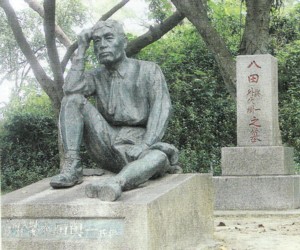 µ©µ»ê©ç¨æ»10NãCAJÆÌíÌÅÉtBswr̪cÍæÁÄ¢½Dð¾ßçêSÈÁĵÜÁ½BªcÌàíÌÞƵÄபñû³ê½Æ«Éæè©êĵÜÁ½BƱ몽ÆCíã©Èè·¢Nª¬êÄ©çCíÉn©³êĵÜÁ½Í¸Ìªc̺ª_Ìß̬®©ç©³ê½Ì¾B ÌíÌ¢ïÌÈ©ÅCªcðç¤n³ÌlXÍCºð·µo³¸Cл©ÉBµÄ¢½Ì¾Á½B¡úCªc̺ÍÓ½½Ñ_ÌÙÆèÉßèC«»¤È÷ÎÝð©×ȪçXƽ½¦çê½
ðßÄ¢éB(J:231)
µ©µ»ê©ç¨æ»10NãCAJÆÌíÌÅÉtBswr̪cÍæÁÄ¢½Dð¾ßçêSÈÁĵÜÁ½BªcÌàíÌÞƵÄபñû³ê½Æ«Éæè©êĵÜÁ½BƱ몽ÆCíã©Èè·¢Nª¬êÄ©çCíÉn©³êĵÜÁ½Í¸Ìªc̺ª_Ìß̬®©ç©³ê½Ì¾B ÌíÌ¢ïÌÈ©ÅCªcðç¤n³ÌlXÍCºð·µo³¸Cл©ÉBµÄ¢½Ì¾Á½B¡úCªc̺ÍÓ½½Ñ_ÌÙÆèÉßèC«»¤È÷ÎÝð©×ȪçXƽ½¦çê½
ðßÄ¢éB(J:231)
Ten years after the completion of stature, Hatta died on the way to the Philippines. His stature was removed when Japan needed metal to continue the war. Although the stature was believed to be melt during the war, it was actually hidden by the local people who appreciate Hatta and his work. Today, the stature was returned to the original place, looking at the water with a smile of satisfaction.
In the 1930fs, Japan introduced the ethnocide policy in Korea and Taiwan forcing Japanese names, language and religion. During the war, Japan mobilized labor and military forces in colonies. The Korean textbook more hysterically blames at Japan than the Taiwanese textbook.
일제는 한국인을 강제 징용으로 끌고 가 광산이나 공장에서 고통스러운 노동을 강요하였고, 지원병 제도와 학병제, 징병제를 실시하여 많은 청년들을 전쟁터로 내몰았다. 일제는 여성들도 근로 보국대, 여자 근로 정신대 등의 이름으로 끌고 가 노동력을 착취하였다. 더욱이 많은 수의 여성을 강제로 동원하여 일본군이 주둔하고 있는 아시아 각 지역으로 보내 군대 위안부로 만들어 비인간적인 생활을 하게 하였다.
(K:262)
Japan drafted Koreans to force painful works in mines and factories and sent many young Korean men to the battle field. Japan also drafted Korean women to extract labor force. In addition, many Korean women were sent to military bases around Asian areas to spend humiliating lives as comfort women.
|
®c¯»^®I¯Cã`Â{½¥²äiàsR伕CªqíãOü^CÔÀwGVã¤ã®¤RCRÁÊu躧xCr³®s¥º§xBíS¯®õIî`C¼1945Nú{³~Ë©B(T:73)
In addition to the ethnocide policy, Japan drafted Taiwanese men as military servants. Some women were sent to the front as comfort women. In the end, Taiwanese men were formally drafted as soldiers. Such mass mobilization lasted until 1945 when Japan surrendered.
|
As a whole, Korean students will think that the Japanese period was doom, depressed and humiliating. On the other hand, Taiwanese students may have bright image for Japanfs rule.
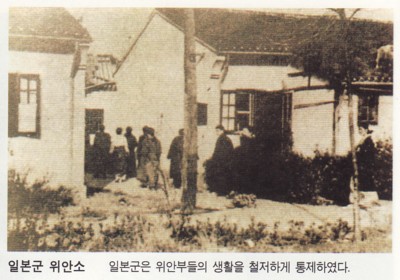 일본군 위안소: 일본군은 위안부들의 생활을 철저하게 제하였다. (K:262)
일본군 위안소: 일본군은 위안부들의 생활을 철저하게 제하였다. (K:262)
Comfort house of the Japanese army: Japan strictly controlled the life of comfort women.
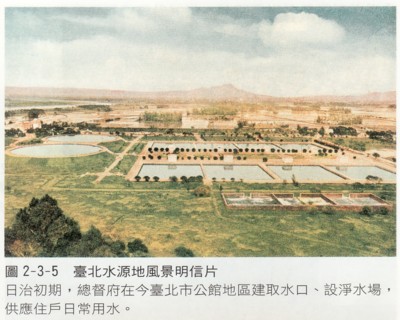 äik
¹ni¾MÐFú¡úCã`Â{Ý¡äiksöÙn½æ
ûRÝÄ
êCäZËúíp
B(T:86)
äik
¹ni¾MÐFú¡úCã`Â{Ý¡äiksöÙn½æ
ûRÝÄ
êCäZËúíp
B(T:86)
Water source of Taipei: In the beginning of the Japanese period, Japan built a water pool and purification plant in Taipei to supply water to inhabitants.
Manchurian Incident
On 18 September 1931, the Kanto Army of Japan destroyed a railway and accused Chinese dissidents of the act. The Kanto Army occupied major cities of Manchuria one after another. While the Japanese textbook does not describe the progress of battles in detail, the Chinese textbook always includes heroic stories when it describes a war.
c]å´Ví¥ãêªÏÈCkçR^úRæêóIílBÝnèR«R¦ÌºCçRgø^éñShISC^úURíC½ÞGCAtodå]µB(C1:71)
The battle of Nenjiang Bridge was the first major encounter in the Manchurian Incident. The defending force bravely fought against Japan under the commandership of Ma Zhanshan. They often forced back the enemy but were severely damaged.
|
In March 1932, Japan declared the establishment of Manchu State and installed Puyi, the last emperor of Qing, as the emperor of Manchuria. Western powers blamed at Japan and sent the Lytton Commission for inspection. When the Lytton Report recommended Japan to retreat its troops, Japan withdrew from the League of Nations. The Chinese textbook does not explain such progress of international affairs but simply stimulates the anger of readers.
ÝúISûºCkOç¯Eß
pJISz¶B(C1:71)
Under the feet of Japanese invaders, 30 million Chinese people were forced to live as slaves.
|
According to the Japanese textbook, there was a remarkable economic development in Manchuria but it did not reduce the anti-Japan sentiment of the Chinese.
»ÌãCú{ÆÆÌ ¢¾Åâí¦èªÎêCBÍÜ°¦aC¤¹yyÝÌX[KÌàÆCú{ÌdHÆÌioÈÇÉæèoϬ·ðÆ°ClÈÇÉæéµ¢lû̬là Á½Bµ©µÀÛÉÍCBÌÀ ÍÖRªÉ¬ÁĨèCêûÅ嬳ܴÜÈRú^®àâ¦é±ÆªÈ©Á½B(J:197)
After an armistice agreement was made between Japan and China, the Manchu State developed economically thanks to heavy industry plants built by Japan. There was a mass in-migration of the Chinese population. However, the Kanto Army controlled the politics and the resistance movement did not decrease.
|
Japan-China War
On 7 July 1937, a battle broke out between the Japanese and Chinese armies at the Marco Polo Bridge nearby Beijing, starting the Japan-China War (Second Sino-Japanese War) that lasted for eight years. Both the Japanese and Chinese textbooks assert that the war started by the provocation of the opposite side.
1937iºa12jN77úéCkxOÌá¸a´ÅCKµÄ¢½ú{RÉü¯Ä½Ò©ªC·éªN«½B±êð«Á©¯ÉCúÍRÆí¬óÔÉÈÁ½iá¸a´jB(J:199)
On the night of 7 July 1937, someone fired at a Japanese unit that was carrying out military training maneuvers at the Marco Polo Bridge. This caused the genuine battle against the Chinese army on the next day.
|
~Ó§®íIú{RàRüá¸a´çRNiUCJà{¶½éBçRE³ÂEC±NïRCS«IRúí]B(C1:175)
The Japanese army attacked the Chinese defense force at the Marco Polo Bridge to start a war. They also cannonaded the Wanping Castle. The Chinese defense force could not persevere it and started countering back. Thus, an all-out war against Japan broke out.
|
The Japanese troops invaded from Shanghai to the inland area and occupied Nanking in December 1937. The Chinese textbook describes the Nanking Massacre in detail to burst the anti-Japan sentiment.
ú{NªÒV|CÄEú©C³«sìBúRèÌìãCÎìl¯is¹äHåjECƺ¹ëVßsBìIa½¯CLIíìûKËI靶qCLIíìûKhEIÎÛCLIíBíãÛR@ìvCúRèÌìãZüVàCjE賡SI¯aúºíImºBO\ÈãB(C1:76-77)
The Japanese invaders burned, killed, robbed and raped everywhere. After taking Nanking, the Japanese army committed a bloody mass murder of inhabitants. Some were used as the targets of shooting practice, some were stubbed with swords, and some were buried alive. According to the statistics at the International Military Tribunal for the Far East, the Japanese killed 300 thousand innocent civilians and retired soldiers during six weeks.
|
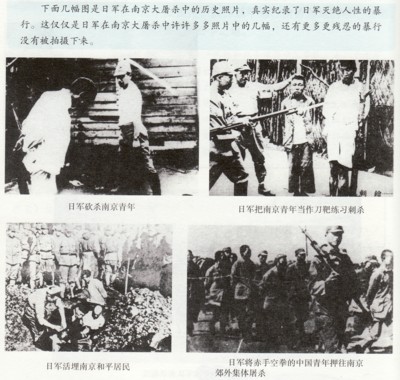
While the death toll of 300 thousand is the official view of the Chinese government, the Japanese textbook writes in a footnote that there is controversy on the detail of incident.
±ÌÆ«Cú{RÉæÁÄCÌR¯É½ÌÒªo½iìjBȨC±ÌÌ]µÒÈÇÌÀÔÉ¢ÄÍ¿ÌãÅ^â_ªo³êC¡úÅप±¢Ä¢éB(J:199)
At this time, a large number of Chinese civilians and soldiers were killed by the Japanese army. There is controversy on details including the death toll in this incident and the investigation still continues today.
|
Pacific War
On 8 December 1941, Japan attacked Pearl Harbor and declared a war on the U.S. Although Japan pushed out the U.S. power to expand its territory at the early stage, the U.S. started countering back after the battle of Midway. The Japanese textbook describes as follows;
úÄ̶YÍ̷ൾ¢É\Ê»µCú{RÍÆÚµ¢íEeòÅêµ¢í¢ð¢ç꽪Cú{Ì«ºÍC±Ìí¢ÉÌ«ª©©ÁÄ¢éCÆM¶ÄæíÁ½B(J:205)
The difference in the industrial production power gradually became apparent. The Japanese soldiers were forced difficult fights with short weapons and ammunition. However, they fought well because they believed that the war determines the countyfs future.
|
In August 1945, the U.S. attacked Hiroshima and Nagasaki with atomic bombs, and the Soviet Union participated in the war against Japan. Japanfs defeat became inevitable. According to the Japanese textbook, the Showa Emperor decided the admission of defeat.
9ú[éCºaVcÌÕÈÌàÆäOïcªJ©ê½B|c_é¾Ì¦óøÉ¢ÄCÓ©Í^Û¯ÆÈÁ½B10úßO2CéØñªVcÌOÉiÝoĹf𠨢¾BVcÍC|c_é¾Ì¦óøÉæéú{Ì~ðfµ½B(J:210)
On the midnight of 9 August 1945, an imperial conference was held. Opinions were half and half on the acceptance of the Potsdam Declaration. When Prime Minister Suzuki Kantaro asked for the decision, the Emperor decided that Japan surrenders by immediately accepting the Potsdam Declaration.
|
The Chinese textbook asserts that Chinafs counterattack was an important reason of Japanfs defeat and that China won ggreat victory.h The textbook also asserts that the Taiwanese people welcomed Chinafs victory and were pleased to back to China.
^¯CIRúíiüå½UBÝl¯a¢E½@¼zÍÊIµdźC815úCú{Vcíéz³ð~BªNRúíCl¯I°æ¾¹ÌåCäpçñcIùøB(C1:83)
At the same time, China started extensive counterattack. Due to the fatal damage from China and other anti-fascist forces all over the world, the Emperor of Japan had to accept unconditional surrender. After the eight year anti-Japan war, the Chinese people won great victory and Taiwan returned to the arms of fatherland.
|
Japanfs defeat ended the colonial rule in Korea and Taiwan. The Korean textbook asserts that Korean resistance movements brought about the independence.
우리가 광복을 맞이할 수 있었던 것은 미국과 소련을 비롯한 연합국의 승리가 가져다 준 결과이기도 하지만, 그 동안 우리 민족이 온 갖 희생을 무릅쓰고 일제에 항거하여 꾸준히 전개해 왔던 독립 운동의 결실이기도 하였다.
(K:297)
When Japan surrendered on 15 August 1945, we Koreans could escape from the cruel rule of the Japanese imperialism. Although this was a result of the victory of Allies including the U.S. and Soviet Union, it was also the outcome of our continuous resistance movements.
|
Taiwan was requisitioned to the Republic of China led by the Kuomintang. Because the Taiwanese textbook negatively evaluates the rule by the Kuomintang immediately after the war, it does not describe Japanfs defeat as a good event like Chinese and Korean textbooks.
1945Ni¯ O\lNjú{³~ãC ¯{¬§äiàsÈs·¯öCÓÚ¾äo¡äiXBs·¯ÂVWsR§@åÜêgCV@ú¡úIäiàsã`ÂG§{dvE±å½RuOÈlv^CBöªÚ¾¯õæá@æþCÁãDà¥jÓRúPoC{÷²äiàsIÆHR¨^å¤C±vuÄrväo¨Jòû»ÛdCøN¯眾sÞBOCäiàs¯眾äoOÈlVÔCçöê¾R¶»äo¶Kµ·ÙCíᢶëðäoà¥[B(T:92)
After Japan surrendered, the Kuomintang established the Chief Executive Office to requisition and govern Taiwan. The Chief Executive Chen Yi owned all the powers of administration and legist ration just like the Governor-General during the Japan period. The gMainlandersh monopolized most of the governmental posts and those officials pocketed requisition goods. In addition, the inflation caused by the retreat of Japanese capitals and exports of foods and goods to the mainland ordered by the government raised the antipathy of the Taiwanese people. Because of the difference in language and customs, troubles between the Taiwanese and Mainlanders took place every day.
|
Korean War
On 25 June 1950, the Korean War broke out between North and South Korea. The United Nations defined North Korea as the invader and sent the UN forces led by Douglas MacArthur. The Japanese, Korean and Taiwanese textbooks agree that North Korea started the war.
1950N6Ck©NÍCìkÌÍêðß´µC\AÌxÌàÆË@ƵÄØÖNUµ½B(J:217)
In June 1950, North Korea abruptly invaded South Korea to unify the peninsula with the military power under the support of the Soviet Union.
북한은 남침 준비를 서두르면서도 겉으로는 남한에 대해 평화 공세를 펴며 남침 의도를 숨기다가, 1950년 6월 25일 새벽에 38도선 전지역에 걸쳐 남침을 감행하였다.
(K:304)
North Korea accelerated the preparation of war while insisted peaceful negotiation to hide its intention. On the early morning of 25 June 1950, however, North Korea suddenly invaded all along the 38th parallel.
1950NCkØÝhâIxºoºìØCDà¥ã1953N7ËâÓñâDB(T:95)
In 1950, North Korea invaded South Korea with the support from the Soviet Union. The war lasted until the armistice agreement was signed in July 1953.
|
In the Chinese textbook, however, the U.S. is defined as the obstructer of the annexation of Taiwan and the intruder threatening China.
üRò÷üNÌóCày|ËkÓ«ésGüæµÍàüNäpC¬Cj~l¯ðúRðúäpBüINª®µdкIÀSB(C2:7)
The U.S. airplanes violated China's territorial sky and bombs destroyed frontier cities in north-eastern China. The U.S. Seventh Fleet invaded the Taiwan Strait to obstruct the liberation of Taiwan by the Peoplefs Liberation Army. These hostile behaviors of the U.S. seriously threatened the security of China.
|
Naturally, the Taiwanese textbook appreciates the appearance of the Seventh Fleet.
¯ O\ãNØDá¢ãCü hæµÍà¦häiàsCÀiêàäiñRRãSàZCÈçj¤Y¨Í°£B(T:95)
When the Korean War broke out in 1950, the U.S. sent the Seventh Fleet to protect Taiwan togethrer. The U.S. also offered military and economic aids to prevent the communistic force to expand.
|
In China, no other opinion is allowed than that the U.S. invaded China and that Chinafs participation in the Korean War was justifiable.
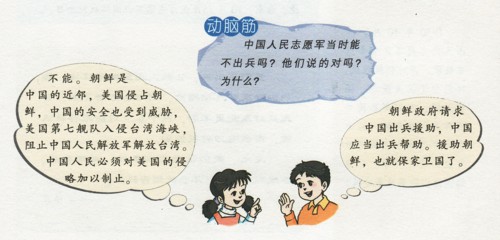
®]Ø Move Your Brain (C2:8)
l¯uÃR\soº嗎? ¼ìàIÎ嗎? ×Yõ?
Could the Peoplefs Liberation Army stay without participating in the war? Were their words correct? Why?
s\B©N¥Iß×CüNè©NCIÀSçóкCüæµÍàüNäpC¬Cj~l¯ðúRðúäpBl¯K{ÎüIN]Áȧ~B
Girl: They could not but participate. While Korea is a neighbor, the U.S. invaded Korea and they even threatened China. The Seventh Fleet invaded the Taiwan Strait to obstruct the liberation by the Peoplefs Liberation Army. The people of China had to resist the invasion of the U.S. and stop it.
©N{¿oº,oºñB©NCçAÛÆq¹B
Boy: North Korean government asked the help of China and in response China sent the army. To help North Korea was to protect our home and country.
|
HOME
 J:wVÒ@Vµ¢ðj³Èx©RÐ, 2009.
J:wVÒ@Vµ¢ðj³Èx©RÐ, 2009. K: 국사편찬위원회, 국정도서편찬위원회, 교육과학기술부, "중학교 국사," 2009년 3월 1일 8쇠 발행.
K: 국사편찬위원회, 국정도서편찬위원회, 교육과학기술부, "중학교 국사," 2009년 3월 1일 8쇠 발행. C1: Ûö³Þ¤EðjÛö³Þ¤JSÒwðj ªNãûxl¯³çoÅÐ, 2009N6æ10óü.
C1: Ûö³Þ¤EðjÛö³Þ¤JSÒwðj ªNãûxl¯³çoÅÐ, 2009N6æ10óü. T: ³çRèC ¯{êNº{úKpwÐðQxìêÇ, 2008.
T: ³çRèC ¯{êNº{úKpwÐðQxìêÇ, 2008.
 Í40ªÅÜÁ½BøÍXtͽ̽eðó¯CåÎÐ𨱵½Bcc±ÌCíðú{Ìɱ¢½ÌÍCC̽¦Ìæ³ÆCZt̺£ëòª¾µ½«\ÎòÉ éÆ¢íêéBcc¢EÌCíjãC±êÙÇ®SÈðûß½áÍÈ©Á½B(J:171)
Í40ªÅÜÁ½BøÍXtͽ̽eðó¯CåÎÐ𨱵½Bcc±ÌCíðú{Ìɱ¢½ÌÍCC̽¦Ìæ³ÆCZt̺£ëòª¾µ½«\ÎòÉ éÆ¢íêéBcc¢EÌCíjãC±êÙÇ®SÈðûß½áÍÈ©Á½B(J:171) µ©µ»ê©ç¨æ»10NãCAJÆÌíÌÅÉtBswr̪cÍæÁÄ¢½Dð¾ßçêSÈÁĵÜÁ½BªcÌàíÌÞƵÄபñû³ê½Æ«Éæè©êĵÜÁ½BƱ몽ÆCíã©Èè·¢Nª¬êÄ©çCíÉn©³êĵÜÁ½Í¸Ìªc̺ª_Ìß̬®©ç©³ê½Ì¾B ÌíÌ¢ïÌÈ©ÅCªcðç¤n³ÌlXÍCºð·µo³¸Cл©ÉBµÄ¢½Ì¾Á½B¡úCªc̺ÍÓ½½Ñ_ÌÙÆèÉßèC«»¤È÷ÎÝð©×ȪçXƽ½¦çê½
ðßÄ¢éB(J:231)
µ©µ»ê©ç¨æ»10NãCAJÆÌíÌÅÉtBswr̪cÍæÁÄ¢½Dð¾ßçêSÈÁĵÜÁ½BªcÌàíÌÞƵÄபñû³ê½Æ«Éæè©êĵÜÁ½BƱ몽ÆCíã©Èè·¢Nª¬êÄ©çCíÉn©³êĵÜÁ½Í¸Ìªc̺ª_Ìß̬®©ç©³ê½Ì¾B ÌíÌ¢ïÌÈ©ÅCªcðç¤n³ÌlXÍCºð·µo³¸Cл©ÉBµÄ¢½Ì¾Á½B¡úCªc̺ÍÓ½½Ñ_ÌÙÆèÉßèC«»¤È÷ÎÝð©×ȪçXƽ½¦çê½
ðßÄ¢éB(J:231) 일본군 위안소: 일본군은 위안부들의 생활을 철저하게 제하였다. (K:262)
일본군 위안소: 일본군은 위안부들의 생활을 철저하게 제하였다. (K:262) äik
¹ni¾MÐFú¡úCã`Â{Ý¡äiksöÙn½æ
ûRÝÄ
êCäZËúíp
B(T:86)
äik
¹ni¾MÐFú¡úCã`Â{Ý¡äiksöÙn½æ
ûRÝÄ
êCäZËúíp
B(T:86)
